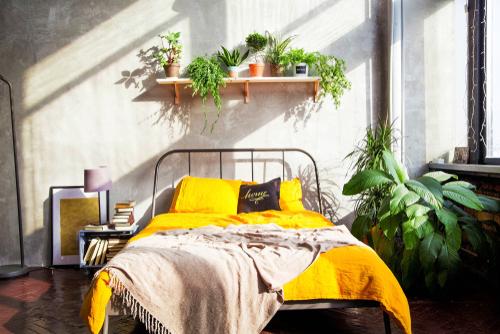
5 of the Science-Backed Plants To Keep In Your Bedroom And Home for Optimal Health
There's something so inviting about a home filled with live plants. Maybe it's the whole idea of having nature indoors or perhaps it's something in our genes tracing back to times when humans spent most of their time outdoors. Regardless of what it is that induces that invitational feel about houseplants in the bedroom or rest of the home, the scientific research into the benefits of indoor plants abounds. Take a peek at five plants to keep in your bedroom or home to improve air quality, help you sleep, and generally benefit your overall health.
1. Jasmine
Jasmine (Gardenia jasminoides) is an attractive plant because of its multitude of small white blossoms, but the thing that makes this flower variety an excellent indoor choice is how it smells. The sweet jasmine fragrance has been shown in German studies to help you sleep better and more peacefully. Plus, you may even wake up with a more positive outlook and a lowered anxiety level. Researchers from the Heinrich Heine University in Dusseldorf found that the fragrance could be just as effective as certain prescription medications for sleep and anxiety.
2. Lavender
Perhaps deserving a place in the bedroom more than anything, a potted lavender (Lavendula) plant could be just what the doctor ordered if you need relaxation at the end of the day, feel anxious, or have issues sleeping. According to published studies, lavender fragrance promotes falling asleep faster and better sleep. But beyond just that, the fragrance of lavender is known to improve emotional health over the course of time for those who have anxiety related to PTSD.
3. Aloe Vera
NASA published an extensive clean air study that shows the power of certain plants to improve indoor air quality, and aloe vera was one of the plants at the top of the list. These spiny succulents filled with therapeutic gel are extremely easy to keep indoors because they do not require a lot of attention. Therefore, aloe vera plants are a good choice for people who don't necessarily have a green thumb. The plant can remove chemicals like formaldehyde and benzene from the air, both of which can be found inside most homes because they are found in a lot of household furnishings and products.
4. Valerian
Valerian (Valeriana officinalis) is a delicate, lacy sort-of plant that has clusters of tiny white or light pink flowers perched atop thicker stems, and it is commonly found growing in the wild. As gorgeous as these flowers are, anyone would love having them around indoors, but they are especially helpful if you have problems sleeping. One study published in 2006 showed that inhaling valerian flower fragrance seemed to enhance sleep quality.
5. English Ivy
You may be more accustomed to finding this charming and creeping plant climbing an old house outdoors, but the English Ivy (Hedera helix) plant is also an excellent choice for the benefit of indoor air quality. English ivy is another one of those plants studied by NASA; it has been shown to remove benzene, formaldehyde, trichloroethylene, xylene, and toluene from the air. Unfortunately, English ivy is toxic to cats and dogs, so this is one to skip if you have indoor pets.
There you have it—a nice list of plants that really deserve a place on your bedside table, dresser, or kitchen counter. Science has shown that we humans really should be in close proximity to plants, even in our living spaces. As always, make sure you talk to your doctor if you have plant-based allergies before bringing any plant into your home.
Source:
https://ntrs.nasa.gov/archive/nasa/casi.ntrs.nasa.gov/19930073077.pdf
https://en.wikipedia.org/wiki/NASA_Clean_Air_Study
https://www.sciencedaily.com/releases/2010/07/100708104320.htm
https://www.ncbi.nlm.nih.gov/pmc/articles/PMC3612440/
https://www.ncbi.nlm.nih.gov/pubmed/16857858





.png?v=14052428765372906161761701960) Previous Post
Previous Post
%20copy.png?v=62173825240595680121761701960)